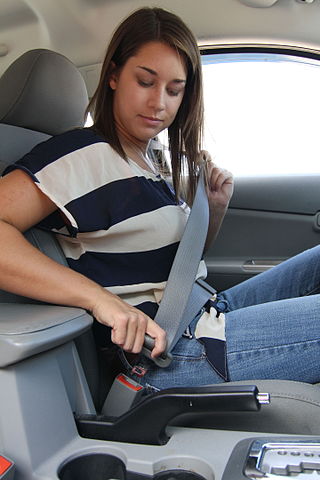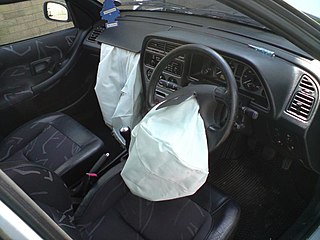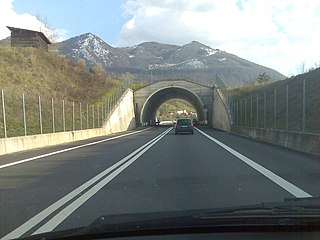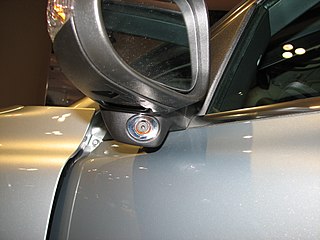
A seat belt, also known as a safety belt or spelled seatbelt, is a vehicle safety device designed to secure the driver or a passenger of a vehicle against harmful movement that may result during a collision or a sudden stop. A seat belt reduces the likelihood of death or serious injury in a traffic collision by reducing the force of secondary impacts with interior strike hazards, by keeping occupants positioned correctly for maximum effectiveness of the airbag, and by preventing occupants being ejected from the vehicle in a crash or if the vehicle rolls over.

An airbag is a vehicle occupant-restraint system using a bag designed to inflate in milliseconds during a collision and then deflate afterwards. It consists of an airbag cushion, a flexible fabric bag, an inflation module, and an impact sensor. The purpose of the airbag is to provide a vehicle occupant with soft cushioning and restraint during a collision. It can reduce injuries between the flailing occupant and the vehicle's interior.

Cruise control is a system that automatically controls the speed of an automobile. The system is a servomechanism that takes over the car's throttle to maintain a steady speed set by the driver.

Automotive safety is the study and practice of automotive design, construction, equipment and regulation to minimize the occurrence and consequences of traffic collisions involving motor vehicles. Road traffic safety more broadly includes roadway design.

Electronic stability control (ESC), also referred to as electronic stability program (ESP) or dynamic stability control (DSC), is a computerized technology that improves a vehicle's stability by detecting and reducing loss of traction (skidding). When ESC detects loss of steering control, it automatically applies the brakes to help steer the vehicle where the driver intends to go. Braking is automatically applied to wheels individually, such as the outer front wheel to counter oversteer, or the inner rear wheel to counter understeer. Some ESC systems also reduce engine power until control is regained. ESC does not improve a vehicle's cornering performance; instead, it helps reduce the chance of the driver losing control of the vehicle.

Advanced driver-assistance systems (ADAS) are technologies that assist drivers with the safe operation of a vehicle. Through a human-machine interface, ADAS increase car and road safety. ADAS use automated technology, such as sensors and cameras, to detect nearby obstacles or driver errors, and respond accordingly. ADAS can enable various levels of autonomous driving.

ZF Friedrichshafen AG, also known as ZF Group, originally Zahnradfabrik Friedrichshafen, and commonly abbreviated to ZF, is a German technology manufacturing company that supplies systems for passenger cars, commercial vehicles and industrial technology. It is headquartered in Friedrichshafen, in the south-west German state of Baden-Württemberg. Specializing in engineering, it is primarily known for its design, research and development, and manufacturing activities in the automotive industry and is one of the largest automotive suppliers in the world. Its products include driveline and chassis technology for cars and commercial vehicles, along with specialized plant equipment such as construction equipment. It is also involved in the rail, marine, defense and aviation industries, as well as general industrial applications. ZF has 162 production locations in 31 countries with approximately 168,700 (2023) employees.

In road-transport terminology, a lane departure warning system (LDWS) is a mechanism designed to warn the driver when the vehicle begins to move out of its lane on freeways and arterial roads. These systems are designed to minimize accidents by addressing the main causes of collisions: driver error, distractions and drowsiness. In 2009 the U.S. National Highway Traffic Safety Administration (NHTSA) began studying whether to mandate lane departure warning systems and frontal collision warning systems on automobiles.
An event data recorder (EDR), more specifically motor vehicle event data recorder (MVEDR), similar to an accident data recorder, (ADR) sometimes referred to informally as an automotive black box, is a device installed in some automobiles to record information related to traffic collisions. In the USA EDRs must meet federal standards, as described within the U.S. Code of Federal Regulations.

The blind spot monitor or blind-spot monitoring is a vehicle-based sensor device that detects other vehicles located to the driver’s side and rear. Warnings can be visual, audible, vibrating, or tactile.
Brake assist or emergency brake assist (EBA) is a term for an automobile braking technology that increases braking pressure in an emergency. The first application was developed jointly by Daimler-Benz and TRW/LucasVarity. Research conducted in 1992 at the Mercedes-Benz driving simulator in Berlin revealed that more than 90% of drivers fail to brake with enough force when faced with an emergency.

Adaptive cruise control (ACC) is a type of advanced driver-assistance system for road vehicles that automatically adjusts the vehicle speed to maintain a safe distance from vehicles ahead. As of 2019, it is also called by 20 unique names that describe that basic functionality. This is also known as Dynamic cruise control.
The following outline is provided as an overview of and topical guide to automobiles:

Vehicle safety technology (VST) in the automotive industry refers to the special technology developed to ensure the safety and security of automobiles and their passengers. The term encompasses a broad umbrella of projects and devices within the automotive world. Notable examples of VST include geo-fencing capabilities, remote speed sensing, theft deterrence, damage mitigation, vehicle-to-vehicle communication, and car-to-computer communication devices which use GPS tracking.

TRW Automotive Holdings Corp. was an American global supplier of automotive systems, modules, and components to automotive original equipment manufacturers (OEMs) and related aftermarkets. Tracing its roots from TRW Inc. it was originally headquartered in Livonia, Michigan. It was created in 2002 when the aerospace company Northrop Grumman purchased TRW and sold its automotive division to Blackstone Group.

A collision avoidance system (CAS), also known as a pre-crash system, forward collision warning system (FCW), or collision mitigation system, is an advanced driver-assistance system designed to prevent or reduce the severity of a collision. In its basic form, a forward collision warning system monitors a vehicle's speed, the speed of the vehicle in front of it, and the distance between the vehicles, so that it can provide a warning to the driver if the vehicles get too close, potentially helping to avoid a crash. Various technologies and sensors that are used include radar (all-weather) and sometimes laser (LIDAR) and cameras to detect an imminent crash. GPS sensors can detect fixed dangers such as approaching stop signs through a location database. Pedestrian detection can also be a feature of these types of systems.
Automotive electronics are electronic systems used in vehicles, including engine management, ignition, radio, carputers, telematics, in-car entertainment systems, and others. Ignition, engine and transmission electronics are also found in trucks, motorcycles, off-road vehicles, and other internal combustion powered machinery such as forklifts, tractors and excavators. Related elements for control of relevant electrical systems are also found on hybrid vehicles and electric cars.
In transportation, collision avoidance is the maintenance of systems and practices designed to prevent vehicles from colliding with each other. They perceive the environment with sensors and prevent collisions using the data collected from the sensors. Collision avoidance is used in autonomous vehicles, aviation, trains and water transport. Examples of collision avoidance include:

NIRA Dynamics AB is a Swedish company focusing on research and development of signal processing and control systems for the automotive industry. It supplies automotive original equipment manufacturers (OEMs) and suppliers in Europe, North America, Latin America, and Asia with its products and systems. In 2021, the number of vehicles equipped with NIRA's main product, TPI, exceeded the benchmark of 75,000,000.

The World Forum for Harmonization of Vehicle Regulations define AEBS. UN ECE regulation 131 requires a system which can automatically detect a potential forward collision and activate the vehicle braking system to decelerate a vehicle with the purpose of avoiding or mitigating a collision. UN ECE regulation 152 says deceleration has to be at least 5 metres per second squared.













